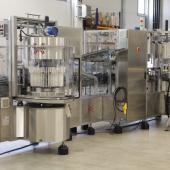Post-Covid food horizons (from the Coop 2020 Report)
A new world (and a new Europe), grappling with violent economic repercussions, is emerging in the aftermath of the pandemic, in an uncertain and suspended trajectory towards the future. The Coop 2020 report investigates the material and immaterial repercussions of this unprecedented scenario on worldviews, lifestyles and consumption habits, devoting an extensive analysis to new trends in the food sector.
The detailed and wide-ranging examination of the post-pandemic scenarios carried out in the Coop 2020 Report - "Consumption and lifestyles of the Italians of today and tomorrow" highlights how different and interconnected factors - anthropological, psychological, economic and sociological - combine to determine a non-homogeneous and non-linear progression amidst the current trends underway.
Using an effective metaphor, it can be said that, both in Italy and in Europe, the health crisis has acted like a time machine on lifestyles, "dragging" us back and forth with extreme rapidity compared to the usual time trends.
On the one hand, an Italy of renunciation has emerged with dramatic clarity, with the collapse of per capita GDP back to the levels of the mid-1990s, travel spending comparable to that of 1975, consumption outside the home three decades behind, to cite just a few of the more macroscopic examples of a "return to the past". On the other hand, in parallel, one can focus on a different face of the country, which leaps forward, speeding up dynamics that already existed, all this within an accelerated timeframe.
This is the Italy of smartworking (+770% compared to a year ago), of egrocery (+132%), of relentless digitization, not only in the private sphere but also in professional activities (work, teaching, services, health...) that has generated an estimated growth, in this market segment, of about 3 billion between 2020 and 2021.
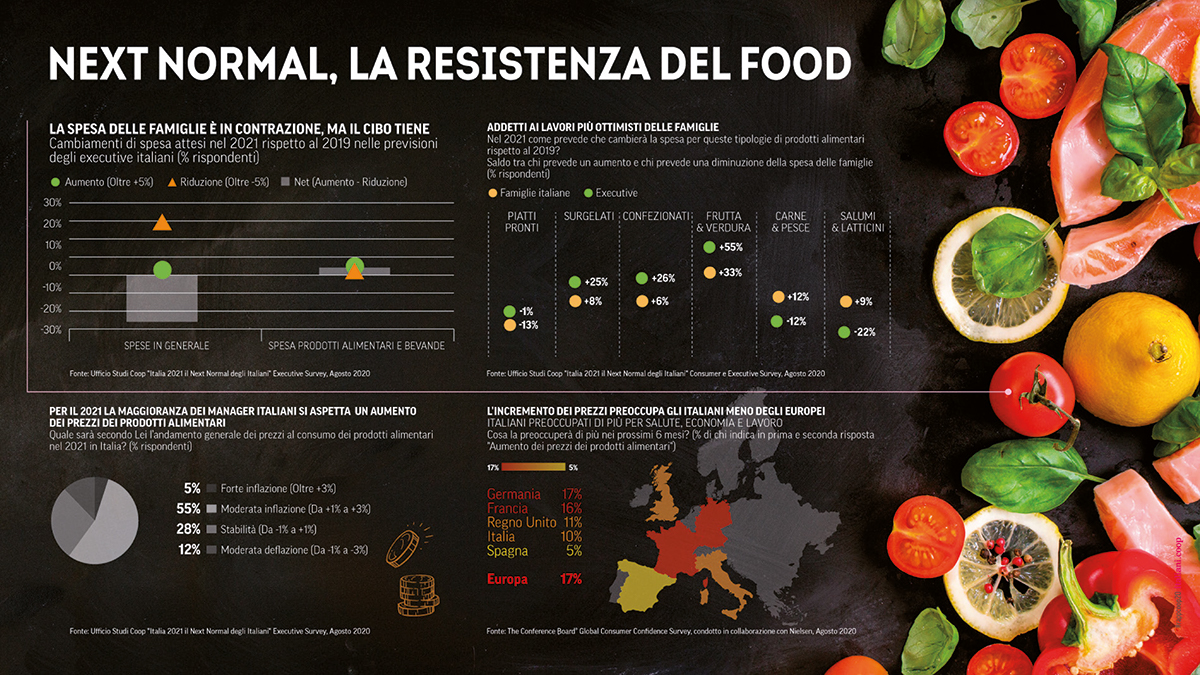
Life in a bubble, but there’s no forsaking (good) food
Considering the impact on perceptions of the world and lifestyles, the common denominator, net of retrocessions and advances, is the widespread feeling of living suspended in a bubble, a condition imposed and necessary during the lockdown, which, nonetheless, still persists today and seems destined to continue in the future.
It is the digital bubble that creates closed and self-referential clusters, of emotional life that is self-delimiting (while generating satisfaction), of short-range travel and the comfort zone of the home that reassures.
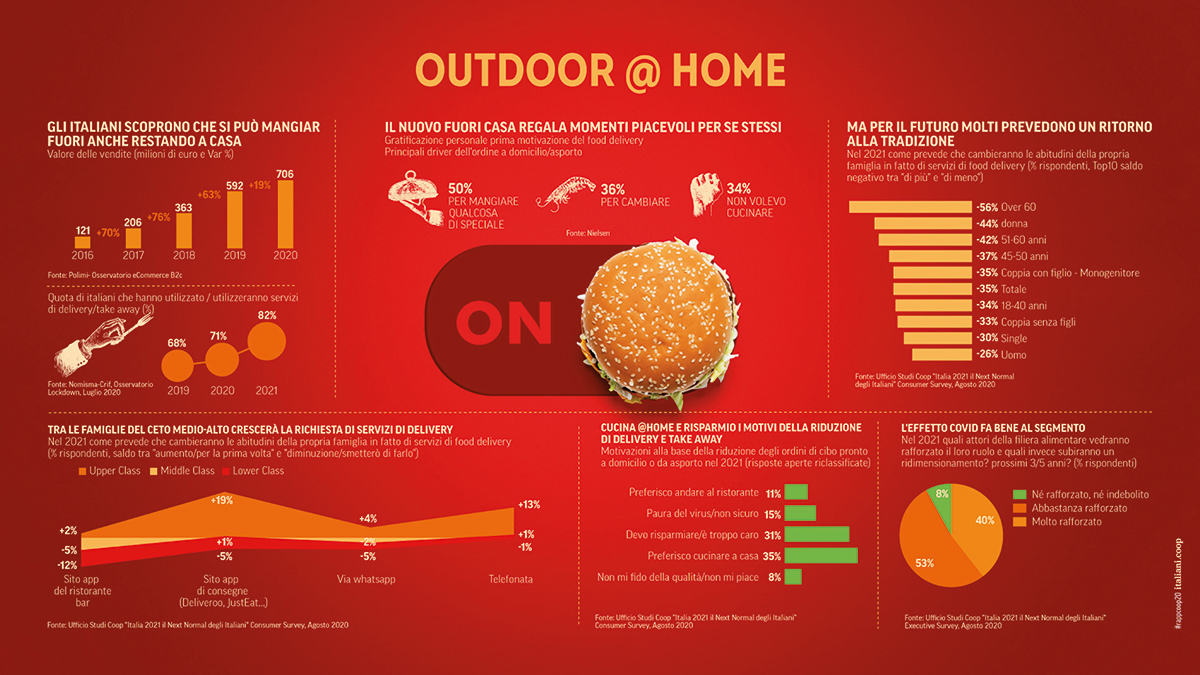
The home as a lifeline to hold on to is coupled with another constant that still distinguishes Italians from their European cousins in the post-covid era: food.
Italians have not rescinded on their food spending, despite the emergency and an evident generalized contraction of purchases: only 31% say they want to buy cheaper packaged consumer products compared to 37% of the European average; a figure much lower than the 50% registered last year and 57% in 2013 (when we were in the midst of an economic crisis with a GDP of -1.8%). And even when the health emergency is over, only 18% say they want to buy cheaper products.
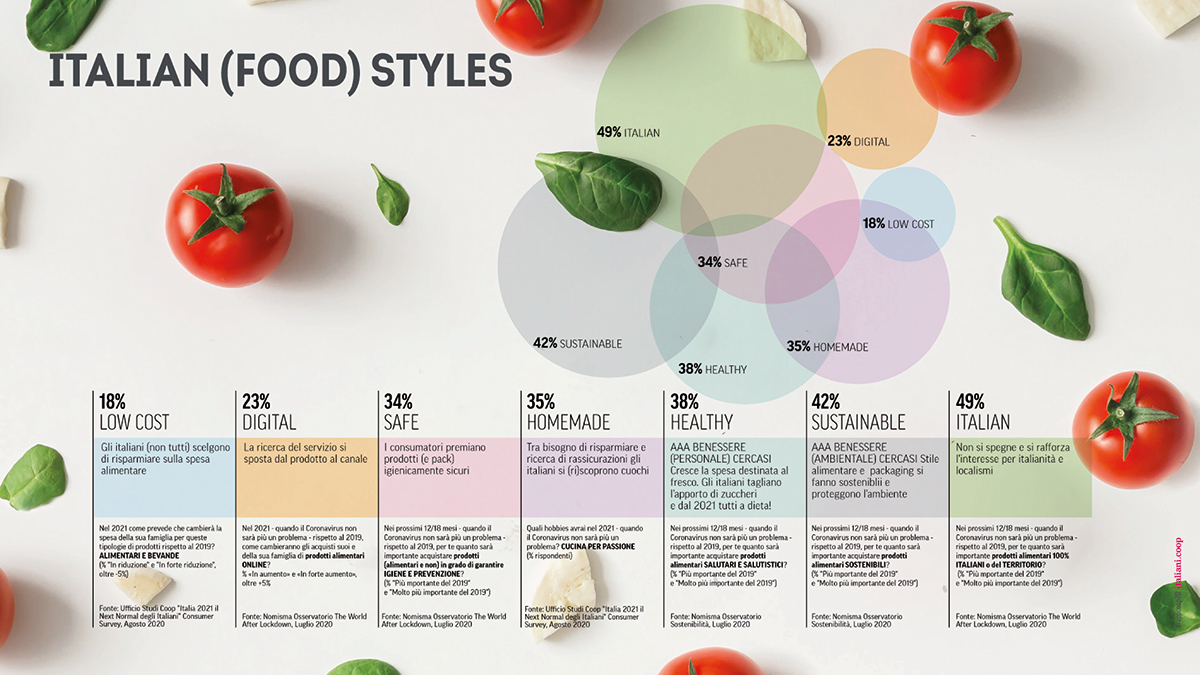
Back to the stove
Taking a discerning look at the supermarket trolley, there is an extraordinary reversal of trends compared to the picture rendered just a year ago by the Coop Report 2019. At the time, it was a flight from the stove, a phenomenon that actually continued in constant progression, so much so that in 20 years the time spent cooking every day has been halved, reduced to just 37 minutes.
As a result of the lockdown, Italians have put their hands back into the dough and even in the post-covid era, cook@home is a constant that explains the strong growth in sales of basic ingredients (+28.5% in largescale retail stores on an annual basis) against the contraction of ready meals (-2.2%).
Whether supported or not by technological aids (sales of food processors in June were up 111% on the previous year), 30% will devote even more time to food preparation and 33% will experiment more.
1 out of 3 will do so to "eat healthy things", but there is also 16% who consider it a way to protect themselves from possible risk of contagion. The domestic preparation of food is also, for many Italians, a strategy for not renouncing quality and, at the same time, lightening their family budget.
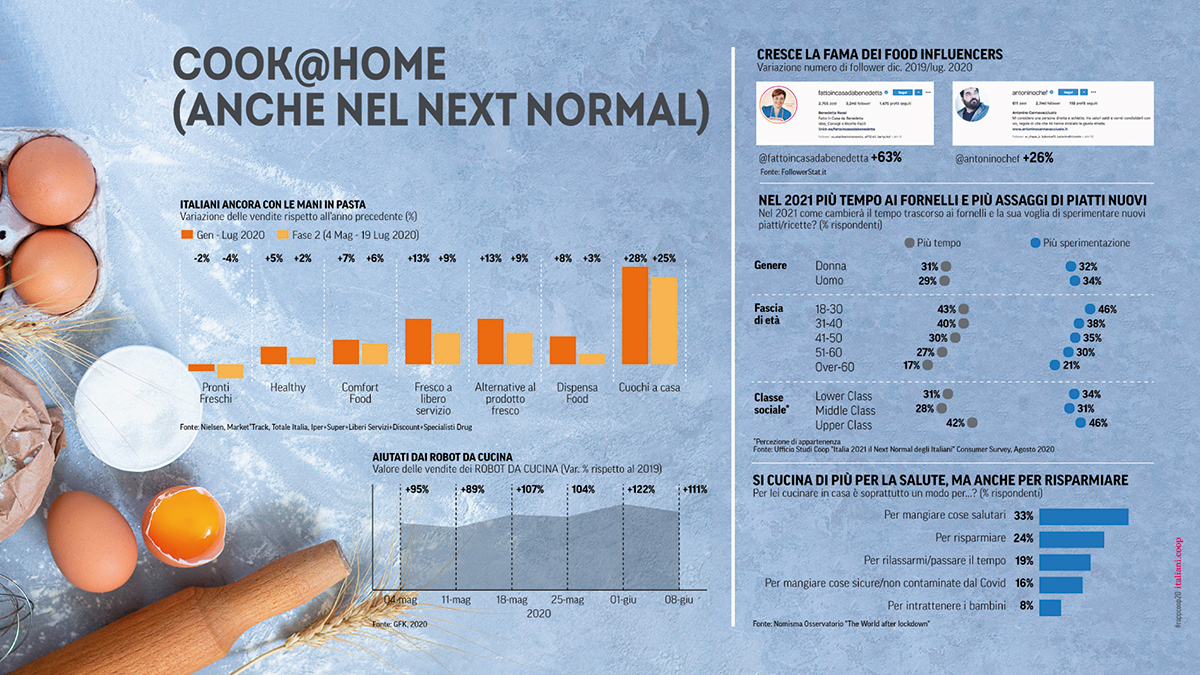
Purchasing trends: shorter supply chain and boom of packaged food
For every second Italian, homegrown "Made in Italy" is becoming even more important than it was in the pre-covid period, when it was already very popular. Moreover, again for safety reasons, this summer has witnessed a vengeful return of packaged food that is growing at a rate more than double that of the entire food sector if compared to a year ago: +2.3% versus +0.5% (June-mid August 2020). Protective and wraparound packaging seems to make the difference in all sectors: fruit and vegetables and even cured meats and dairy products. While going back to the supermarket trolley, still in the summer, gourmet (+16.9%), ethnic (+15.4%) and vegan (+6.9%) foods are gaining strength.
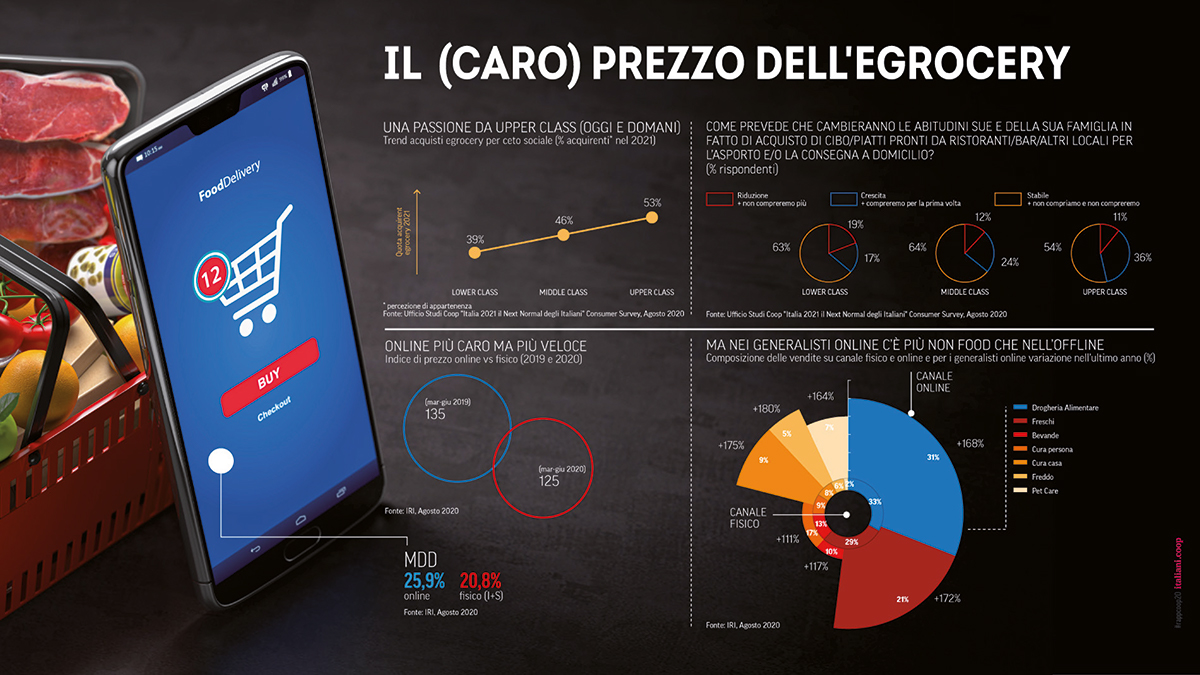
Efood, an evolving segment
After the explosion during the lockdown, there is no sign of a decrease in the trend towards food purchases through online channels.
Alongside pure ecommerce, however, Italians also seem to want to choose mixed solutions; click&collect, for example, goes from 7.2% of online sales in 2019 to 15.6% in the post-pandemic phase.
And there are also those (42%) who still consider the advice of the shopkeeper/counter staff important, proving that the keyword seems to be increasingly multichannel.
A deterrent is the high price of online: +25% compared to the physical cart (March-June 2020). A price gap decreased compared to 2019 when it stood at +35%, but still such that digital spending is a widespread habit among families with medium-high incomes: the share of egrocery buyers goes from 39% of the working class to 53% of the upper class. And it will still be the latter that will drive demand in the near future (43% say so).
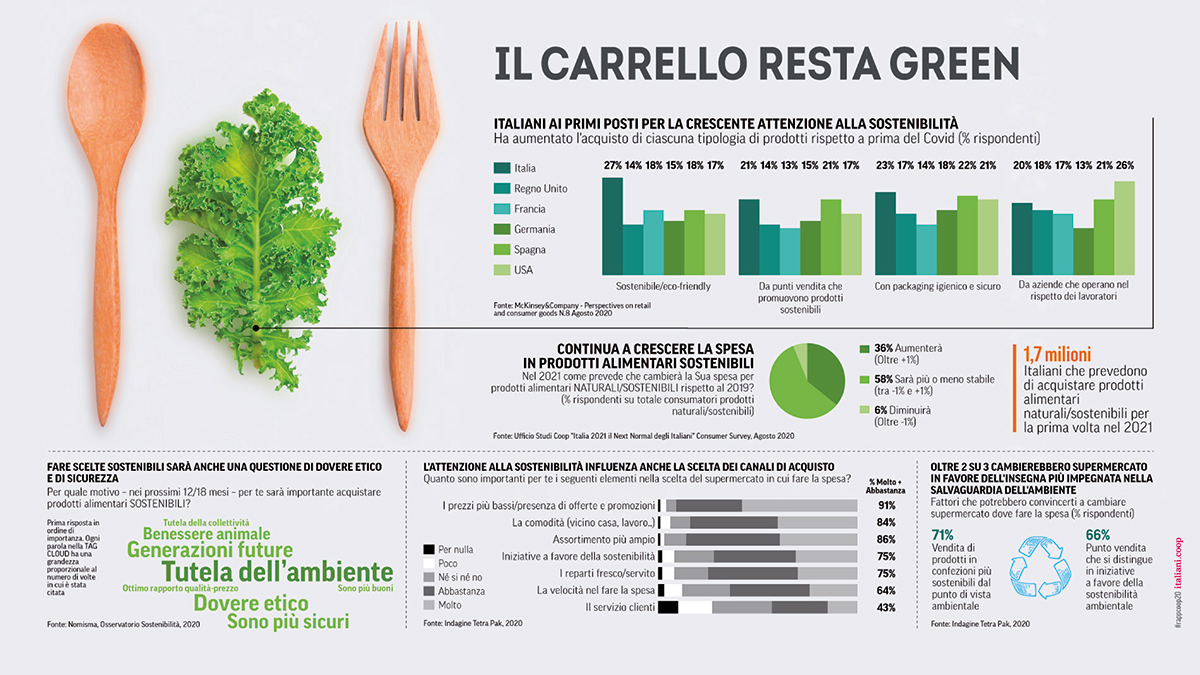
Attention to sustainability
Among the constants not swept away by Covid, the growing attention to sustainability, which translates into related purchasing trends. 27% of Italy’s residents are buying more sustainable/ecofriendly products than before Covid; 21% have increased purchases at stores that promote sustainable products, and 20% are buying more from companies that are worker-friendly. It is also estimated that 1,700,000 Italians will turn to green purchases for the first time once the emergency is over.
















